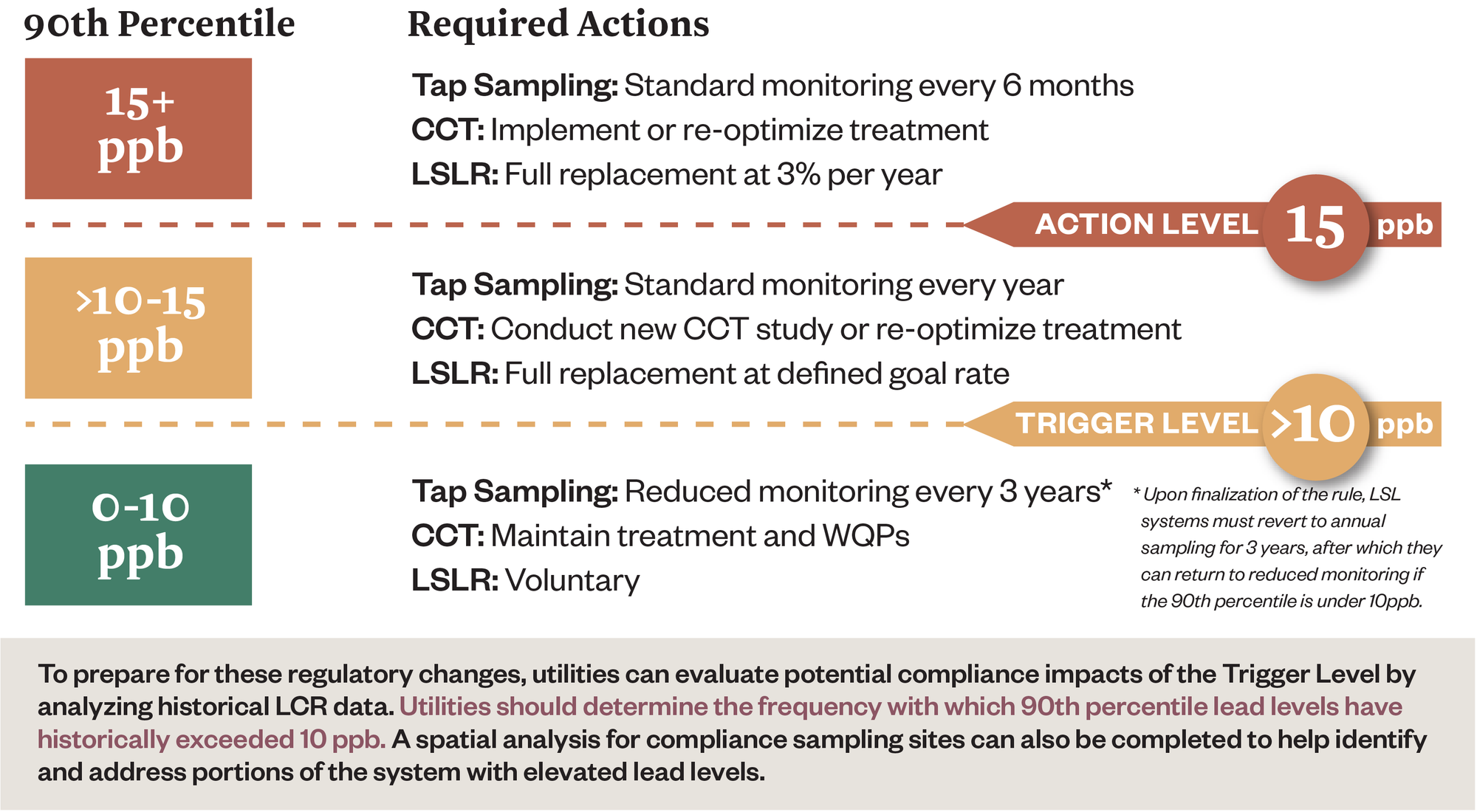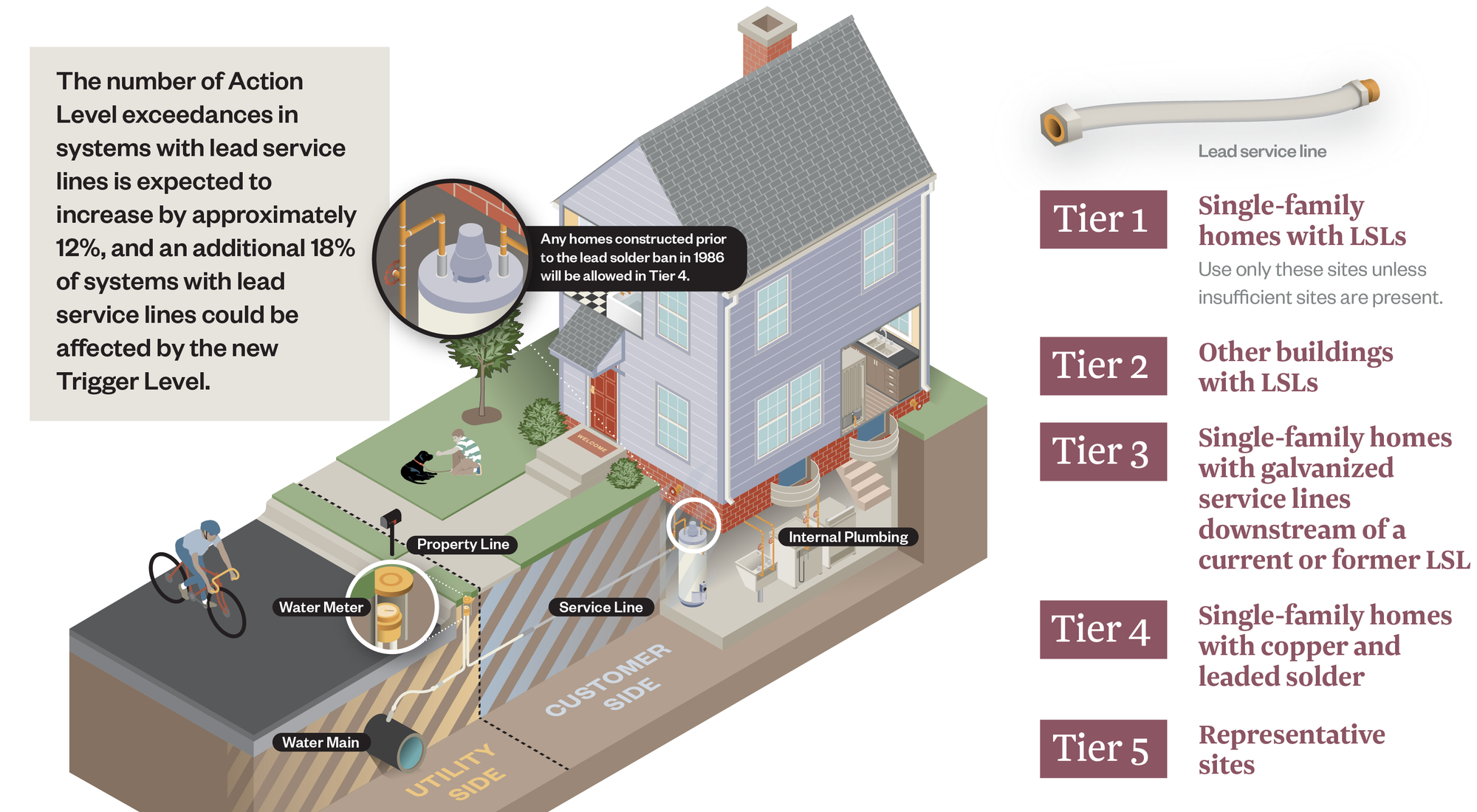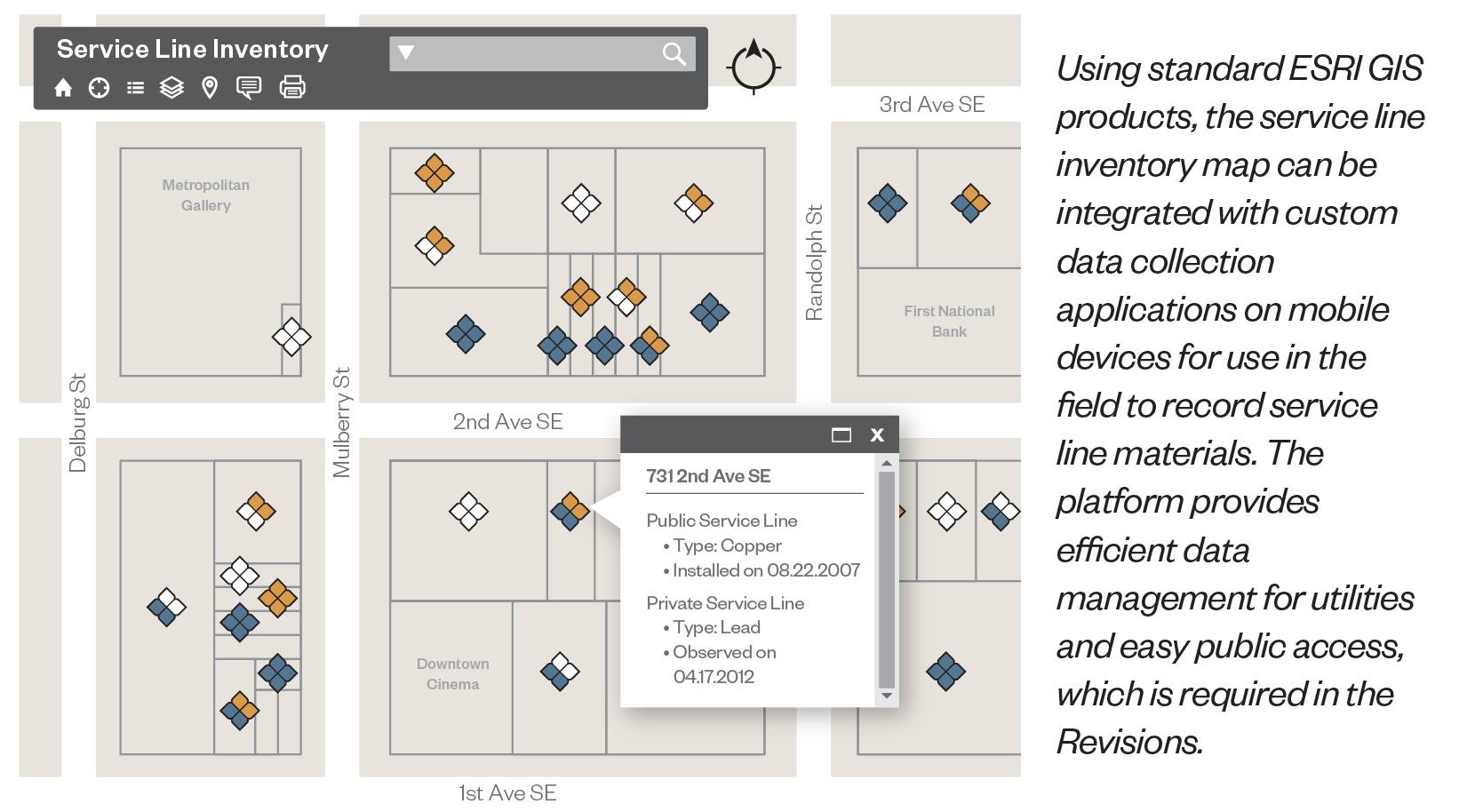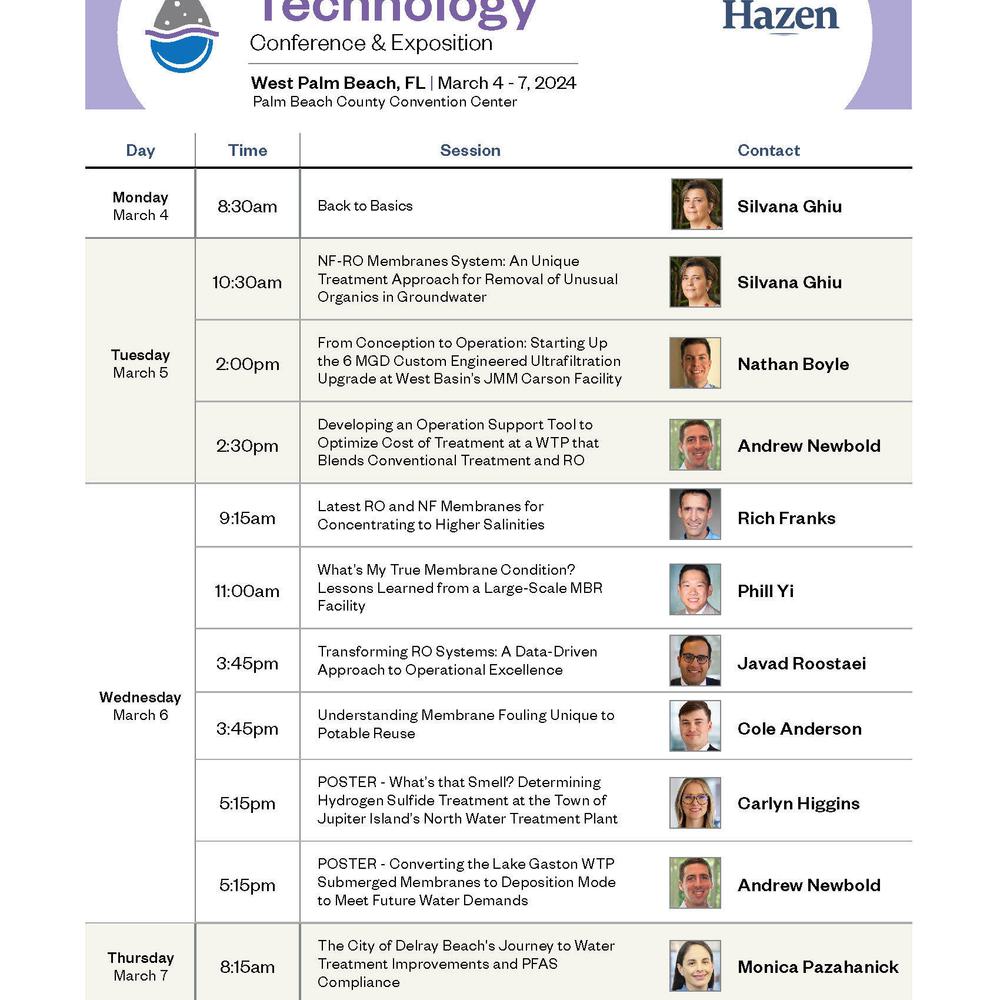Lead and Copper Rule Revisions
These revisions will significantly alter how utilities implement corrosion control treatment, conduct compliance sampling, manage lead service lines, and communicate with customers.
The Lead and Copper Rule (LCR), established in 1991, requires utilities to monitor and control lead and copper levels in drinking water. The LCR Revisions were promulgated in January 2021 and include sweeping changes to many aspects of the Rule, constituting the first major update to the National Primary Drinking Water Regulations in more than a decade and impacting every U.S. water system.
Understanding the implications of these Revisions will allow utilities to plan for continued compliance, and Hazen has developed an online interactive tool to help utilities proactively prepare:
The Lead and Copper Rule (LCR), established in 1991, requires utilities to monitor and control lead and copper levels in drinking water. The LCR Revisions were promulgated in January 2021 and include sweeping changes to many aspects of the Rule, constituting the first major update to the National Primary Drinking Water Regulations in more than a decade and impacting every U.S. water system.
The Revisions will significantly alter how utilities implement corrosion control treatment, conduct compliance sampling, manage lead service lines, and communicate with customers.
Lead and Copper Tap Sampling Prioritizes LSLs
The LCR Revisions redefine compliance site selection criteria and place a priority on sampling from sites with the highest potential for lead release—those containing lead service lines. Water systems will need to reevaluate their LCR sample site selection to determine if compliance monitoring locations comply with the proposed tier requirements.
The LCR Revisions also introduce additional sampling requirements. For systems with lead service lines, compliance sampling will include a first liter and a fifth liter sample, which monitors lead release directly from the lead service line. This fifth liter sampling protocol may substantially increase observed lead levels for some systems compared to the conventional first-draw approach. Utilities will be required to adopt new protocols for evaluating and mitigating lead release on a site-specific basis, increasing utility coordination and communication with customers. Utilities will also be required to sample from schools and childcare facilities, where high-risk populations, including children, are present. To meet this requirement, utilities will need to develop a sampling plan for these high-risk locations and develop procedures to communicate both the sampling results and potential actions the location can take to reduce lead in drinking water.

Changes Further Protect Public Health Efforts
In addition to the current Maximum Contaminant Level Goal (MCLG) of zero and Action Level (AL) of 15 ppb for lead, the revised LCR aims to strengthen corrosion control treatment and further protect public health by establishing a new trigger level (TL) of 10 ppb. The Revisions define a tiered response of required actions based upon the level of exceedance (trigger level and action level). Approximately 10% of systems surveyed in Hazen’s 2019 Corrosion Control Treatment Survey reported historical 90th percentile Pb levels between 10 and 15 ppb and would be affected by the proposed Trigger Level. For systems with lead service lines, sampling protocol changes may further increase observed lead levels above the TL.
Corrosion Control Treatment Becomes High Priority
According to the Revisions, utilities will be required to conduct a corrosion control study if either the lead trigger level or action level is exceeded. Utilities may also be required to conduct a corrosion control study prior to a source water or treatment change, or if the USEPA or state regulatory agency deems the utility’s current corrosion control treatment not optimal.

Based on the new requirements of the LCR Revisions, the number of systems needing to evaluate corrosion control treatment is expected to increase substantially. Nearly 20% of systems that currently meet the action level could exceed the trigger level and require a corrosion control study.
When corrosion control testing is required, the LCR Revisions require the use of pipe loops with harvested lead service lines for evaluating corrosion control techniques. This form of testing is more labor and time intensive and utilities will need to plan accordingly. Systems without lead service lines can consider other types of corrosion testing including bench-scale immersion testing. Systems will also be required to evaluate specific orthophosphate doses (1 mg/L and 3 mg/L as PO4), which is expected to push systems to use higher orthophosphate doses than historical norms.
Case Study: Cobb County-Marietta Water Authority (CCMWA) is a regional public utility that provides wholesale potable water to 13 retail, industrial, and institutional water suppliers and is the second largest supplier of safe drinking water in Georgia. CCMWA, along with its wholesale customers, has historically reported lead and copper levels that are well below the EPA action levels. However, in recent years, there have been a growing number of reported pinhole leaks in copper plumbing throughout systems served by CCMWA. As a result, CCMWA chose to take a proactive approach towards corrosion control to evaluate pinhole leaks and prepare for upcoming regulatory changes to the LCR.
The study included a detailed desktop corrosion control evaluation, transmission and distribution system sampling, bacterial analysis, and a comprehensive scale analysis of harvested copper pipes. While historical LCR data showed lead and copper levels well below action levels, a historical water quality analysis revealed the propensity for soft water pitting. Further analysis revealed the absence of a protective carbonate scale within the existing pipe scales and the presence of copper sulfate hydroxides in pitting caps, all characteristic of soft water pitting. Recommendations for optimizing corrosion control within the CCMWA system included the stabilization of finished water pH along with either increasing finished water alkalinity or the addition of orthophosphate.
A pilot-scale pipe loop study is currently being conducted to evaluate the effectiveness of various corrosion control techniques in controlling copper pitting as well as the leaching of lead and copper into drinking water. Corrosion control techniques being evaluated include orthophosphate and zinc orthophosphate along with pH adjustment.
Developing Service Line Inventories
Where present, lead service lines are the primary source of lead in drinking water. The first step in understanding and addressing lead service line risks is to determine their locations in the system. The LCR Revisions require all water systems to develop a publicly available inventory of all publicly and privately-owned service lines in the distribution system, which must be submitted within 3 years. For large systems, the service line inventory must be posted to a publicly available website in electronic format (interactive maps are recommended due to ease of use for customers).
Systems will be required to submit annual notification letters to all customers with lead service lines or service lines of unknown material. While many systems have unknown service line materials (often historically assumed to be non-lead), the LCR Revisions will require unknown service line materials to be presumptive lead. By improving the accuracy of the inventory to reduce unknown materials, the burden of regulatory requirements associated with LSL notifications and required LSL replacement can be alleviated.
To prepare for inventory development, systems can review historical records about local LSL use and analyze property data to identify portions of the system more likely to contain LSLs. Utilities with paper records of service line installation date or material should review or digitize service line records. While the LCR Revisions do not explicitly require service line identification, utilities may also benefit from developing procedures for service line identification in the field. As unknown service lines will be presumed to be lead service lines for compliance purposes, utilities will need strategies to systematically identify service lines to reduce the number of unknowns in the system over time.
Expansion of Lead Service Line Replacement
The LCR Revisions aim to accelerate the removal of sources of lead in drinking water by expanding full lead service line replacement (LSLR) requirements and mitigating the potential for lead exposure during the replacement process.
Systems with unknown or lead service lines will be required to develop a Lead Service Line Replacement Plan establishing how a utility intends to perform LSLRs within the system for voluntary replacements or mandatory replacements in response to a Trigger Level or Action Level exceedance. The LCR Revisions require utilities to establish a goal rate for LSLR and identify methods that they will use to fund the replacements as part of the LSLR Plan.
Systems exceeding the Trigger Level or Action Level at the 90th percentile will be required to replace full LSLs, including privately-owned portions, at a specified rate. In this scenario, partial LSL replacements do not count towards replacement rate requirements, and customer coordination is critical to encourage customer acceptance of private LSLR. Annual notifications to customers with LSLs may also increase the number of private LSLRs. When notified of a private LSLR, the water system has 45 days to replace the public LSL.
Case Study: The City of Chesapeake (VA) retained Hazen to develop a LSLR Plan to proactively prepare to identify and replace LSLs and protect public health. Like many water utilities, the City had observed LSLs during water utility projects but had minimal available records to indicate existing LSL locations and did not have an established approach for identifying and replacing LSLs.
A preliminary assessment of LSL quantity and likely locations in the City was performed using historical records research of local plumbing codes, utility construction standards, published industry research, and City staff knowledge. The City’s Real Estate Assessors’ database was used to analyze building construction dates as an indicator of potential service line installation dates and materials. Water distribution main installation date and material records were also analyzed to identify potential areas with LSLs. Based on the records research and data analysis, it was estimated that anywhere from 1,400 to 7,000 LSLs may be present within the City. Geographic areas with the greatest likelihood to contain LSLs were delineated and service line identification efforts within these areas were prioritized.

An action plan for LSL identification and replacement was developed. This included a protocol for full LSLR, including customer outreach, funding, and protocols to mitigate lead exposure. The City reviewed legal barriers to private LSLR and developed approaches to encourage customers to agree to private LSLR. As the City is not legally able to pay for private service line work, the City obtained grant funding for private LSLR through the Virginia Department of Health LSLR grant program. Working with the City, Hazen also developed of a geospatial service line inventory tool and mobile field data collection application to facilitate service line data collection during routine utility repairs and replacement.
Looking Ahead
The Revisions will significantly expand utility responsibilities associated with privately-owned infrastructure issues, through the sampling protocol changes, service line inventory, and full LSLR requirements. They will also further expand public outreach and education needs through more frequent customer contact and annual service line notification letters.
The Revisions will drive a major change in the ways that utilities communicate and coordinate with customers about lead in drinking water. Utilities can proactively prepare for continued compliance by assessing trigger level impacts, performing proactive “fifth liter” sampling, evaluating corrosion control treatment, and developing a framework for service line tracking, identification, and replacement.










